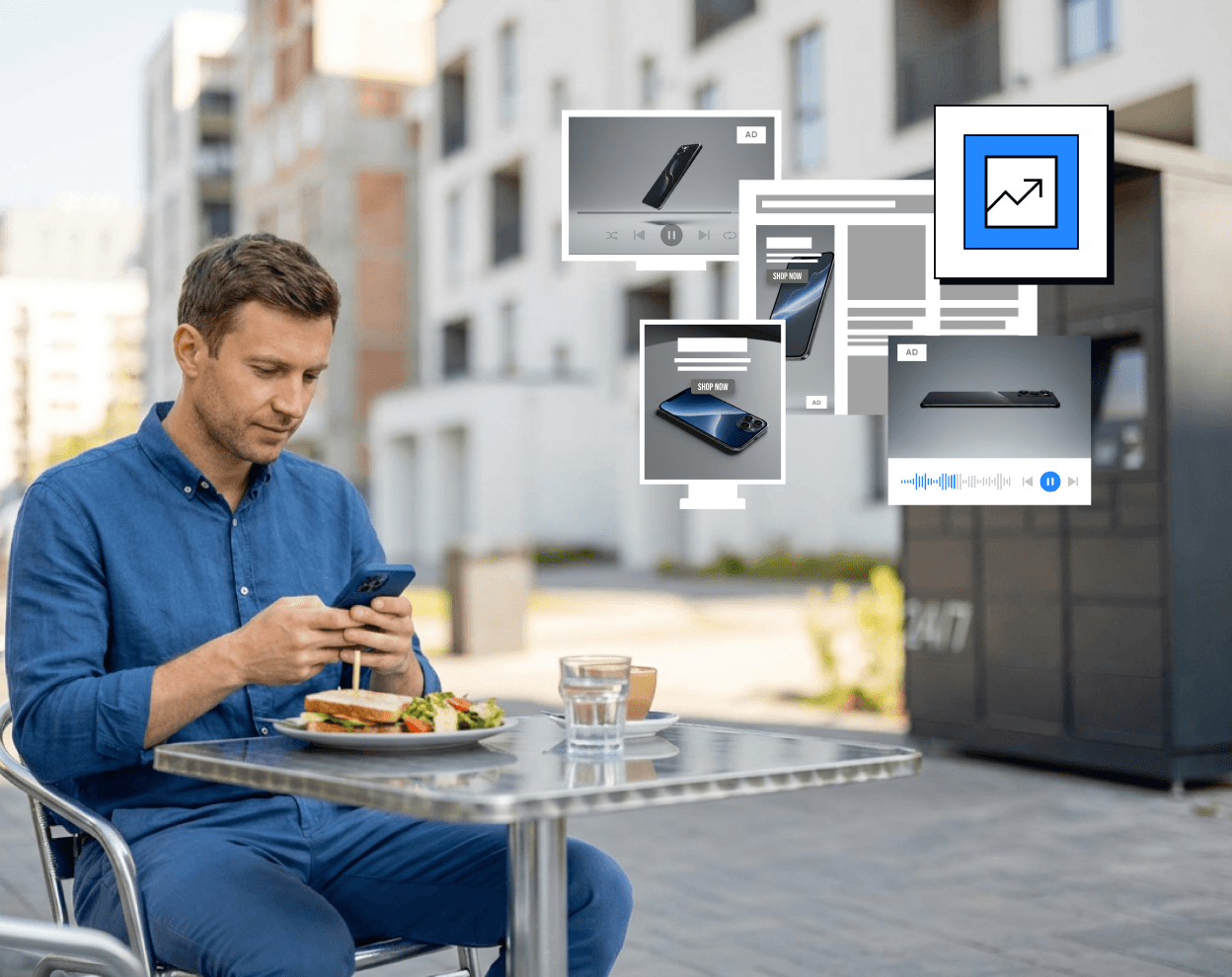Location-based marketing has become one of the most powerful ways for brands to influence consumer behavior in real time. Instead of broadcasting generic ads, companies can activate campaigns tied to a user’s location, interests, and moments of intent. This shift has elevated geofencing and beacons as essential technologies within digital marketing strategies. Both rely on real-world positioning to connect with customers through their mobile devices, yet they operate differently, deliver different levels of precision, and serve distinct marketing goals.
In this article, we’ll dive into how geofencing and beacons work and help you choose the right approach to reach your target audience, enhance customer engagement, and improve conversion rates across the whole consumer journey.
What Is Geofencing and How Does It Work?
Geofencing uses GPS, IP addresses, and, in some environments, Wi-Fi signals to create virtual boundaries around a geographic location. These virtual boundaries allow brands to trigger advertising or communication when a device enters, dwells, or exits a specific area. The defined perimeter might be a storefront, a busy downtown block, a competitor’s location, or even an entire city.
When a consumer’s device crosses this virtual boundary, a geofencing campaign can automatically deliver location-based ads on social media, websites, and apps they already use. The experience does not require a brand’s app to be installed, reducing friction and expanding reach. In addition to real-time targeting, marketers can re-engage users who visited a location in the past 30 days through strategic retargeting, strengthening attribution and campaign optimization.
Geofencing supports both broad and highly targeted initiatives. A brand can target an entire neighborhood during a major local event, or activate a smaller radius around its physical location to drive foot traffic. Geotargeting based on demographics, consumer behavior, and mobile movement enriches audience precision and helps ensure advertising budgets reach people most likely to convert.
Because geofencing does not require Bluetooth or dedicated hardware, setup is fast and cost-effective. Any business that wants to reach customers based on real-world location can get started quickly, without technical installation or high upfront expense.
What Are Beacons
Beacons are small, wireless Bluetooth Low Energy (BLE) transmitters installed in physical locations. They interact with nearby devices, generally within a few meters, enabling exact proximity marketing. To activate a beacon experience, users must download and opt into the brand’s app and keep Bluetooth turned on. Once these conditions are met, the brand can trigger personalized messages and notifications based on a user's exact location within a store.
This hyper-specific accuracy allows beacons to enhance the in-store experience through product recommendations, aisle-level promotions, guided navigation, and loyalty program activations. A shopper browsing shoes could receive a notification with a limited-time discount. A museum visitor might receive additional content when standing in front of a particular exhibit. A sports fan seated in a stadium section may get exclusive offers tied to seat location.
The result is a high level of relevance and utility directly connected to a user’s location, which can significantly increase time spent in the store and average ticket value. However, the reliance on installation, app adoption, and Bluetooth introduces barriers. Casual or first-time visitors may never experience a beacon interaction because the required conditions are not met.
Geofencing vs. Beacons: Function and Fit
While both approaches fall under location-based marketing, their operations determine when each is most effective. Geofencing is designed to reach mobile users across broader areas, including those who have never interacted with the brand. It excels in awareness, acquisition, and retargeting campaigns that influence behavior outside the store. Beacons, in contrast, activate engagement during a visit and support retention strategies by personalizing the customer journey.
A retailer might use geofencing to attract shoppers near a competitor’s location, then use beacons to deepen the connection once the customer enters the store. One tool drives traffic. The other builds loyalty.
Accuracy is another distinction. Geofencing can identify the general area where someone is located, while beacons can pinpoint their exact location within that area. If the objective is to direct a potential customer to the store during a moment of intent, geofencing provides the necessary scale. If the aim is to improve the user experience once the person is already inside the store, beacons enable precise targeting down to individual product displays.
When Geofencing Is the Better Option
Most brands begin with geofencing because it requires minimal effort and offers immediate reach. Campaigns can scale across multiple locations, focus on strategic geographic areas, and retarget users who have recently visited. It enables marketers to influence decision-making during the most critical phase of the purchase journey, when people are nearby, searching, and ready to act.
Geofencing is also valuable for businesses that want clarity on attribution. When someone sees an ad triggered by a specific location and then goes to the store, that real-world action can be measured. With continuous performance data, marketers can refine their audience and allocate budget based on what actually drives conversions and revenue.
When Beacons Provide More Value
For brands with a strong app user base and consistent foot traffic, beacons can take customer experience to the next level. They strengthen loyalty programs, increase incremental purchases, and deliver relevant content at precisely the moment customers need it. Because they capture real-time location inside the store, they unlock rich behavioral insights. Where customers spend time, which displays they linger near, and which aisles they skip all become measurable points of intelligence that support ongoing experience optimization.
Beacons are most effective when customers already love the brand. They work best in environments where people return frequently, such as supermarkets, sports arenas, airports, and retail chains that emphasize loyalty rewards.
Choosing the Best Technology for Your Marketing Strategy
Both technologies contribute to more efficient and more human advertising. The deciding factor is your marketing objective. If the immediate goal is to bring new customers to your physical location, geofencing is the most efficient and scalable option. If the goal is to elevate the in-store journey for customers who already engage with your brand, beacons create value that reinforces loyalty and increases transaction volume.
The strongest strategies recognize that the customer journey does not start or end at the store entrance. Many retailers combine geofencing and beacons to create a seamless flow of communication from discovery to purchase to repeat visits. One focuses on reaching the right people. The other ensures they have the right experience once they decide to walk in.
Agility Makes Location-Based Marketing Perform
Agility enables marketers to activate campaigns tied to real-world consumer movement with precision and performance. Our platform enables targeting users by geographic location without the need for expensive hardware or technical hurdles. We help you optimize investments and enhance attribution, ensuring that your advertising dollars reach people who are ready to take action.
If you are ready to make location-based targeting a growth engine for your brand and connect brand investments directly to real-world results, our team is here to help you move faster and smarter. Contact us to launch your next precision brand advertising campaign.
FAQ
Do users need to install an app for geofencing to work?
No. Geofencing can activate ads across websites and apps that consumers already use. This makes it highly scalable, particularly for brands looking to reach new audiences. While app data can enhance targeting and personalization, an app is not required for geofencing to function effectively.
Which technology is more accurate: geofencing or beacons?
Beacons are more precise, often accurate to within a few meters or even centimeters, depending on the device's proximity. Geofencing offers high accuracy at large scales but is affected by GPS availability and building structures. The decision comes down to whether the goal is to influence consumers near the location or to guide behavior within the area.
Which permissions do consumers need to enable?
Geofencing typically leverages location services already enabled on the device for apps and maps. Beacons require multiple layers of opt-in: Bluetooth activation, app installation, and permission granted within the app. As a result, activation barriers are higher for beacons but lead to deeper personalization once permission is granted.
Are location-based marketing solutions privacy compliant?
Yes. Both geofencing and beacons operate within strict privacy frameworks that require user consent and anonymized data handling. Agility’s campaigns are designed with privacy-by-default standards, ensuring data is used responsibly and transparently to improve user experience rather than intrude on it.
Can geofencing work indoors?
It can, mainly when Wi-Fi assists GPS in areas with weaker satellite visibility. However, beacon technology remains the superior choice for detailed indoor location awareness. Many brands use both: geofencing to bring customers to a store and beacons to support them once they are inside.
How do these technologies support attribution and optimization?
Geofencing enables visit-based attribution by measuring whether a user exposed to an ad later visited the location. This allows marketers to connect media spend to real-world outcomes. Beacons enable in-store attribution by revealing what customers interact with upon arrival, helping retailers improve layout, messaging, and product placement.
Share in...





